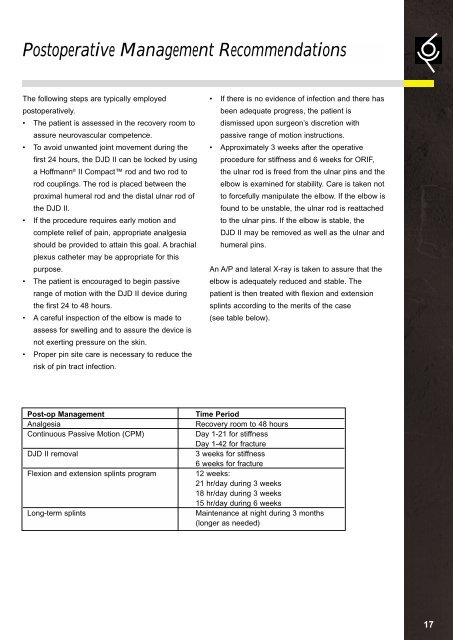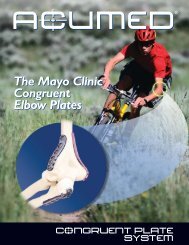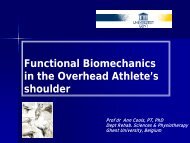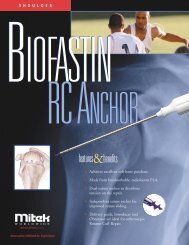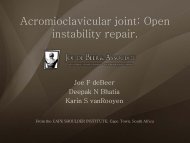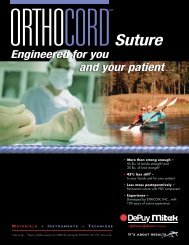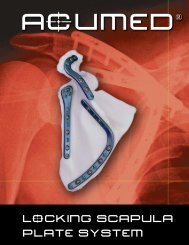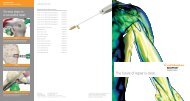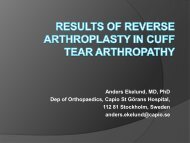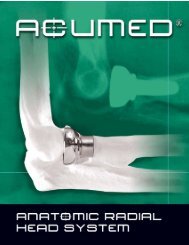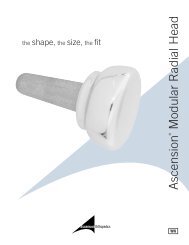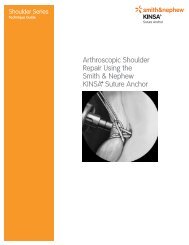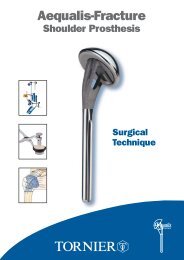DJD External Fixator, Stryker - ShoulderDoc.co.uk
DJD External Fixator, Stryker - ShoulderDoc.co.uk
DJD External Fixator, Stryker - ShoulderDoc.co.uk
You also want an ePaper? Increase the reach of your titles
YUMPU automatically turns print PDFs into web optimized ePapers that Google loves.
Postoperative Management Re<strong>co</strong>mmendations<br />
The following steps are typically employed<br />
postoperatively.<br />
• The patient is assessed in the re<strong>co</strong>very room to<br />
assure neurovascular <strong>co</strong>mpetence.<br />
• To avoid unwanted joint movement during the<br />
first 24 hours, the <strong>DJD</strong> II can be locked by using<br />
a Hoffmann ® II Compact rod and two rod to<br />
rod <strong>co</strong>uplings. The rod is placed between the<br />
proximal humeral rod and the distal ulnar rod of<br />
the <strong>DJD</strong> II.<br />
• If the procedure requires early motion and<br />
<strong>co</strong>mplete relief of pain, appropriate analgesia<br />
should be provided to attain this goal. A brachial<br />
plexus catheter may be appropriate for this<br />
purpose.<br />
• The patient is en<strong>co</strong>uraged to begin passive<br />
range of motion with the <strong>DJD</strong> II device during<br />
the first 24 to 48 hours.<br />
• A careful inspection of the elbow is made to<br />
assess for swelling and to assure the device is<br />
not exerting pressure on the skin.<br />
• Proper pin site care is necessary to reduce the<br />
risk of pin tract infection.<br />
• If there is no evidence of infection and there has<br />
been adequate progress, the patient is<br />
dismissed upon surgeon’s discretion with<br />
passive range of motion instructions.<br />
• Approximately 3 weeks after the operative<br />
procedure for stiffness and 6 weeks for ORIF,<br />
the ulnar rod is freed from the ulnar pins and the<br />
elbow is examined for stability. Care is taken not<br />
to forcefully manipulate the elbow. If the elbow is<br />
found to be unstable, the ulnar rod is reattached<br />
to the ulnar pins. If the elbow is stable, the<br />
<strong>DJD</strong> II may be removed as well as the ulnar and<br />
humeral pins.<br />
An A/P and lateral X-ray is taken to assure that the<br />
elbow is adequately reduced and stable. The<br />
patient is then treated with flexion and extension<br />
splints ac<strong>co</strong>rding to the merits of the case<br />
(see table below).<br />
Post-op Management Time Period<br />
Analgesia Re<strong>co</strong>very room to 48 hours<br />
Continuous Passive Motion (CPM) Day 1-21 for stiffness<br />
Day 1-42 for fracture<br />
<strong>DJD</strong> II removal 3 weeks for stiffness<br />
6 weeks for fracture<br />
Flexion and extension splints program 12 weeks:<br />
21 hr/day during 3 weeks<br />
18 hr/day during 3 weeks<br />
15 hr/day during 6 weeks<br />
Long-term splints Maintenance at night during 3 months<br />
(longer as needed)<br />
17


